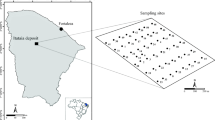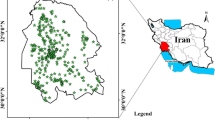Abstract
The potential of mid-infrared spectroscopy in combination with partial least-squares regression was investigated to estimate total and phosphate-extractable arsenic contents in soil samples collected from a highly variable arsenic-contaminated disused cattle-dip site. Principal component analysis was performed prior to mid-infrared partial least-squares analysis to identify spectral outliers in the absorbance spectra of soil samples. The mid-infrared partial least-squares calibration model (n = 149) excluding spectral outliers showed an acceptable reliability (coefficient of determination, \(R_{\text{c}}^{2}\) = 0.75 (P < 0.01); ratio of performance to interquartile distance, RPIQc = 2.20) to estimate total soil arsenic. For total soil arsenic, the validation of final calibration model using 149 unknown samples also resulted in a good acceptability with \(R_{\text{v}}^{2}\) = 0.67 (P < 0.05) and RPIQv = 2.01. However, the mid-infrared partial least-squares calibration model based on phosphate-extractable arsenic was not acceptable to estimate the extractable (bioavailable) arsenic content in soil (\(R_{\text{c}}^{2}\) = 0.13 (P > 0.05); RPIQc = 1.37; n = 149). The results show that the mid-infrared partial least-squares prediction model based on total arsenic can provide a rapid estimate of soil arsenic content by taking into account the integrated effects of adsorbed arsenic, arsenic-bearing minerals and arsenic associated with organic components in the soils. This approach can be useful to estimate total soil arsenic in situations, where analysis of a large number of samples is required for a single soil type and/or to monitor changes in soil arsenic content following (phyto)remediation at a particular site.




Similar content being viewed by others
References
Bellon-Maurel V, Fernandez-Ahumada E, Palagos B, Roger JM, McBratney A (2010) Critical review of chemometric indicators commonly used for assessing the quality of the prediction of soil attributes by NIR spectroscopy. Trends Anal Chem 29(9):1073–1081
Carabante I, Grahn M, Holmgren A, Hedlund J (2010) In situ ATR-FTIR studies on the competitive adsorption of arsenate and phosphate on ferrihydrite. J Colloid Interface Sci 351(2):523–531
Chabot M, Hoang T, Al-Abadleh HA (2009) ATR-FTIR studies on the nature of surface complexes and desorption efficiency of p-arsanilic acid on iron (oxyhydr)oxides. Environ Sci Technol 43(9):3142–3147
Chen M, Ma LQ (1998) Comparison of four USEPA digestion methods for trace metal analysis using certified and Florida soils. J Environ Qual 27(6):1294–1300
Cornell RM, Schwertmann U (2003) The iron oxides: structure, properties, reactions, occurrences, and uses (trans: Schwertmann U). 2nd, completely rev. and extended edn. Wiley-VCH, Weinheim
Forouzangohar M, Kookana RS, Forrester ST, Smernik RJ, Chittleborough DJ (2008) Midinfrared spectroscopy and chemometrics to predict diuron sorption coefficients in soils. Environ Sci Technol 42(9):3283–3288
Geladi P (1988) Notes on the history and nature of partial least squares (PLS) modelling. J Chemometrics 2:231–246
Goldberg S (2002) Competitive adsorption of arsenate and arsenite on oxides and clay minerals. Soil Sci Soc Am J 66(2):413–421
Goldberg S, Johnston CT (2001) Mechanisms of arsenic adsorption on amorphous oxides evaluated using macroscopic measurements, vibrational spectroscopy, and surface complexation modeling. J Colloid Interface Sci 234(1):204–216
Grafe M, Eick MJ, Grossl PR (2001) Adsorption of arsenate (V) and arsenite (III) on goethite in the presence and absence of dissolved organic carbon. Soil Sci Soc Am J 65(6):1680–1687
Grafe M, Eick MJ, Grossl PR, Saunders AM (2002) Adsorption of arsenate and arsenite on ferrihydrite in the presence and absence of dissolved organic carbon. J Environ Qual 31(4):1115–1123
Haaland DM, Thomas EV (1988) Partial least-squares methods for spectral analyses. 2. Application to simulated and glass spectral data. Anal Chem 60(11):1202–1208
Huang PM, Fujii R (1996) Selenium and arsenic. In: Sparks DL (ed) Methods of soil analysis. Part 3, chemical methods. Soil Science Society of America Inc, Wisconsin, pp 793–831
Hubert AE (1983) Determination of arsenic in geological materials by x-ray fluorescence spectrometry after solvent extraction and deposition on a filter. Talanta 30(12):967–968
Ibrahim M, Hameed AJ, Jalbout A (2008) Molecular spectroscopic study of River Nile sediment in the greater Cairo region. Appl Spectrosc 62(3):306–311
Isbell RF (2002) The Australian soil classification, revised edn. CSIRO, Collingwood
Islam K, Singh B, McBratney A (2003) Simultaneous estimation of several soil properties by ultra-violet, visible, and near-infrared reflectance spectroscopy. Aust J Soil Res 41(6):1101–1114
Janik LJ, Skjemstad JO (1995) Characterization and analysis of soils using mid infrared partial least squares. 2. Correlations with some laboratory data. Aust J Soil Res 33(4):637–650
Janik LJ, Skjemstand JO, Raven MD (1995) Characterization and analysis of soils using mid infrared partial least squares. 2. Correlations with some laboratory data. 1. Correlations with XRF-determined major element composition. Aust J Soil Res 33(4):621–636
Janik LJ, Merry RH, Forrester ST, Lanyon DM, Rawson A (2007) A rapid prediction of soil water retention using Mid Infrared spectroscopy. Soil Sci Soc Am J 71:507–514
Jia Y, Xu L, Wang X, Demopoulos GP (2007) Infrared spectroscopic and X-ray diffraction characterization of the nature of adsorbed arsenate on ferrihydrite. Geochim Cosmochim Acta 71(7):1643–1654
Johnston CT, Aochi CT (1996) Fourier transform infrared and Raman spectroscopy. In: Sparks DL (ed) Methods of soil analysis, part 3: chemical methods. Soil Science Society of America, Madison, pp 269–321
Kimber SWL, Sizemore DJ, Slavich PEG (2002) Is there evidence of arsenic movement at cattle tick dip sites? Aust J Soil Res 40(7):1103–1114
Kookana RS, Janik LJ, Forouzangohar M, Forrester ST (2008) Prediction of atrazine sorption coefficients in soils using mid-infrared spectroscopy and partial least-squares analysis. J Agric Food Chem 56(9):3208–3213
Lin HT, Wang MC, Li GC (2004) Complexation of arsenate with humic substance in water extract of compost. Chemosphere 56(11):1105–1112
Mandal BK, Suzuki KT (2002) Arsenic round the world: a review. Talanta 58(1):201–235
Mark H (1992) Data analysis: multilinear regression and principal components analysis. In: Burns DA, Ciurcester EW (eds) Handbook of near infrared analysis. Marcel Dekker, San Diego
Mckenzie N, Jacquier D, Isbell RF, Katharine B (2004) Australian soils and landscapes: an illustrated compendium. CSIRO, Collingwood
McLaren RG, Naidu R, Smith J, Tiller KG (1998) Fractionation and distribution of arsenic in soils contaminated by cattle dip. J Environ Qual 27(2):348–354
Minasny B, McBratney AB, Tranter G, Murphy BW (2008) Using soil knowledge for the evaluation of mid-infrared diffuse reflectance spectroscopy for predicting soil physical and mechanical properties. Eur J Soil Sci 59(5):960–971
Moros J, de Vallejuelo SFO, Gredilla A, de Diego A, Madariaga JM, Garrigues S, de la Guardia M (2009) Use of reflectance infrared spectroscopy for monitoring the metal content of the estuarine sediments of the Nerbioi-Ibaizabal River (Metropolitan Bilbao, Bay of Biscay, Basque Country). Environ Sci Technol 43(24):9314–9320
Niazi NK, Bishop TFA, Singh B (2011a) Evaluation of spatial variability of soil arsenic adjacent to a disused cattle-dip site, using model-based geostatistics. Environ Sci Technol 45(24):10463–10470
Niazi NK, Singh B, Shah P (2011b) Arsenic speciation and phytoavailability in contaminated soils using a sequential extraction procedure and XANES spectroscopy. Environ Sci Technol 45(17):7135–7142
Niazi NK, Singh B, Van Zwieten L, Kachenko AG (2011c) Phytoremediation potential of Pityrogramma calomelanos var. austroamericana and Pteris vittata L. grown at a highly variable arsenic contaminated site. Int J Phytorem 13(9):912–932
Niazi NK, Singh B, Zwieten LV, Kachenko AG (2012) Phytoremediation of an arsenic-contaminated site using Pteris vittata L. and Pityrogramma calomelanos var. austroamericana: a long-term study. Environ Sci Pollut Res 19:3506–3515
O’Reilly SE, Strawn DG, Sparks DL (2001) Residence time effects on arsenate adsorption/desorption mechanisms on goethite. Soil Sci Soc Am J 65(1):67–77
Pirie A, Singh B, Islam K (2005) Ultra-violet, visible, near-infrared, and mid-infrared diffuse reflectance spectroscopic techniques to predict several soil properties. Aust J Soil Res 43(6):713–721
Sanghavi BJ, Srivastava AK (2010) Simultaneous voltammetric determination of acetaminophen, aspirin and caffeine using an in situ surfactant-modified multiwalled carbon nanotube paste electrode. Electrochim Acta 55(28):8638–8648
Sanghavi BJ, Mobin SM, Mathur P, Lahiri GK, Srivastava AK (2013a) Biomimetic sensor for certain catecholamines employing copper(II) complex and silver nanoparticle modified glassy carbon paste electrode. Biosensors Bioelectron 39(1):124–132
Sanghavi BJ, Sitaula S, Griep MH, Karna SP, Ali MF, Swami NS (2013b) Real-time electrochemical monitoring of adenosine triphosphate in the picomolar to micromolar range using graphene-modified electrodes. Anal Chem 85(17):8158–8165
Schroeder PA (2002) Teaching clay science. In: Rule A, Guggenheim S (eds) CMS workshop lectures, vol 11. The Clay Mineral Society, Aurora, pp 181–206
Smith E, Naidu R, Alston AM (1998) Arsenic in the soil environment: a review. Adv Agron 64:149–195
Smith AH, Arroyo AP, Mazumder DNG, Kosnett MJ, Hernandez AL, Beeris M, Smith MM, Moore LE (2000) Arsenic-induced skin lesions among Atacameno people in Northern Chile despite good nutrition and centuries of exposure. Environ Health Perspect 108(7):617–620
Song Y, Li F, Yang Z, Ayoko GA, Frost RL, Ji J (2012) Diffuse reflectance spectroscopy for monitoring potentially toxic elements in the agricultural soils of Changjiang River Delta, China. Appl Clay Sci 64:75–83
Wenzel WW, Kirchbaumer N, Prohaska T, Stingeder G, Lombi E, Adriano DC (2001) Arsenic fractionation in soils using an improved sequential extraction procedure. Anal Chim Acta 436(2):309–323
Acknowledgments
The first author gratefully acknowledges the Higher Education Commission of Pakistan for the award of a PhD scholarship. The project has been assisted by the NSW Government through its Environmental Trust. Thanks to Dr Lukas van Zwieten, Stephen Kimber, George Nastase, Joshua Rust, Scott Petty, Desmond Cook and Victor Warren at the Wollongbar Agricultural Research Institute, Wollongbar for field assistance.
Author information
Authors and Affiliations
Corresponding author
Electronic supplementary material
Below is the link to the electronic supplementary material.
Rights and permissions
About this article
Cite this article
Niazi, N.K., Singh, B. & Minasny, B. Mid-infrared spectroscopy and partial least-squares regression to estimate soil arsenic at a highly variable arsenic-contaminated site. Int. J. Environ. Sci. Technol. 12, 1965–1974 (2015). https://doi.org/10.1007/s13762-014-0580-5
Received:
Revised:
Accepted:
Published:
Issue Date:
DOI: https://doi.org/10.1007/s13762-014-0580-5




